You also want an ePaper? Increase the reach of your titles
YUMPU automatically turns print PDFs into web optimized ePapers that Google loves.
Chapter 2<br />
Next, we define an object with a testObj variable with a property named<br />
testObjFunc that receives a reference to testF()—don't fret if you are not really<br />
aware of object creation yet. By doing this, we created a testObjMethod() method.<br />
Now, when we invoke this method, we expect the function context to be displayed<br />
when we display the value of this.<br />
Invocation as a constructor<br />
Constructor functions are declared just like any other functions and there's nothing<br />
special about a function that's going to be used as a constructor. However, the way in<br />
which they are invoked is very different.<br />
To invoke the function as a constructor, we precede the function invocation with the<br />
new keyword. When this happens, this is bound to the new object.<br />
Before we discuss more, let's take a quick introduction to object orientation in<br />
<strong>JavaScript</strong>. We will, of course, discuss the topic in great detail in the next chapter.<br />
<strong>JavaScript</strong> is a prototypal inheritance language. This means that objects can inherit<br />
properties directly from other objects. The language is class-free. Functions that<br />
are designed to be called with the new prefix are called constructors. Usually, they<br />
are named using PascalCase as opposed to CamelCase for easier distinction. In<br />
the following example, notice that the greet function uses this to access the name<br />
property. The this parameter is bound to Person:<br />
var Person = function (name) {<br />
this.name = name;<br />
};<br />
Person.prototype.greet = function () {<br />
return this.name;<br />
};<br />
var albert = new Person('Albert Einstein');<br />
console.log(albert.greet());<br />
We will discuss this particular invocation method when we study objects in the next<br />
chapter.<br />
Invocation using apply() and call() methods<br />
We said earlier that <strong>JavaScript</strong> functions are objects. Like other objects, they also<br />
have certain methods. To invoke a function using its apply() method, we pass two<br />
parameters to apply(): the object to be used as the function context and an array<br />
of values to be used as the invocation arguments. The call() method is used in a<br />
similar manner, except that the arguments are passed directly in the argument list<br />
rather than as an array.<br />
[ 63 ]<br />
www.it-ebooks.info


